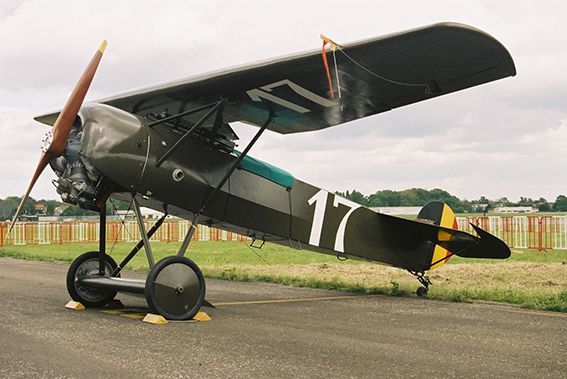
Fokker D. VIII
The Fokker EV was the fifth monoplane fighter aircraft designed by the Dutchman Anthony Fokker for the German Military Aviation (Fliegertruppe). In May 1918 he decided to build this monoplane with parasol wing and rotary engine. In June 1918 he took part in the 2nd competition for fighter aircraft in Adlershof. Fokker's design was a convincing winner and the EV immediately went into production. The first planes were already delivered in June and sent to the front without delay.
They surpassed the other fighter aircraft in performance and climbing ability. The weak point of the EV, however, was the weak wing construction and production was halted after a few accidents. Fokker was obliged to build new wings with reinforced spars for the 139 aircraft already delivered. To distinguish the adapted aircraft, they were designated D.VIII. A further 150 units of the new type with reinforced wings were delivered in the following months. In the meantime it was already October 1918 and due to the rapid evolution of the fighter aircraft, the D.VIIIs had already been surpassed before they even reached the front. Many of them ended up in depots.
After the Armistice of November 11, 1918, a large number of German warplanes were distributed among the victors. In Evere near Brussels there was a large German aircraft depot (Armee Flug Park) and among the aircraft, fuselages and wings stored there was at least one Fokker EV that had been brought up to D.VIII standard. Aircraft that were not interesting for incorporation into our Military Aviation, if they were not scrapped, sometimes ended up in the private possession of military pilots.
Lieutenant Albert Van Cotthem's EV/D.VIII.
On August 4, 1914, Van Cotthem is mobilized and joins his unit, the 'Carabiniers Cyclistes'. Shortly afterwards he becomes a relay racer and later a driver for a general. This last post is not well received and Albert submits an application to be transferred to the flying units. Van Cotthem is very popular in the flight school, because of his cool-headedness and his knowledge of mechanics. In March 1916 he is transferred to the front as a fighter pilot. On June 16, he won his first victory. In 1917 we find Albert back at the airfield of Beaumarais-Calais where the technical centre led by Georges Nelis (founder of SNETA/Sabena) has taken up residence. Here he is appointed test pilot of the new and restored aircraft. He is put in charge of the acrobatics school.
The end of the war does not mark the end of Van Cotthem's flying career. Van Cotthem is also involved in the establishment of SNETA. He is the one who flies the first commercial flights Brussels-Paris-Brussels , Brussels-London-Brussels and Brussels-Folkestone-Brussels.
Albert Van Cotthem was one of the private pilots who bought a German Fokker. This is how the EV/D.VIII came into the hands of Lieutenant Albert Van Cotthem. On May 15, 1920 he resigned from the SNETA to concentrate on aerial acrobatics and participated in numerous meetings and flying parties with "his" aircraft.
For example at the International Meeting of Antwerp from 17 to 21 July 1920, at the Antwerp Olympiad in August and September of that year (where he became Olympic champion in aerial acrobatics by beating competitors such as Fonck, Nungesser and Fronval) and the meeting and competition of Evere on 4 and 5 June 1921. At that last event the aircraft was provided with the participation number “17”.
In 1939, Albert Van Cotthem was again called into arms and appointed commander of the military flight school of Deurne.
In 1949, Albert Van Cotthem becomes “Dean of Aviation”, a title that Jan Olieslagers was the first to receive.
Stampe en Vertongen Museum vzw
Antwerp International Airport
Bus 3
B-2100 Antwerp-Deurne
Belgium
O.N. BE0447.236.613
RPR Antwerp
email: stampe@skynet.be
www.stampe.be
Opening hours individual visits
- Mon - Fri
- Closed
- Sat - Sun
- -
Closed on Easter Sunday and during August, December and January
Useful links
All rights reserved | Stampe en Vertongen Museum vzw






